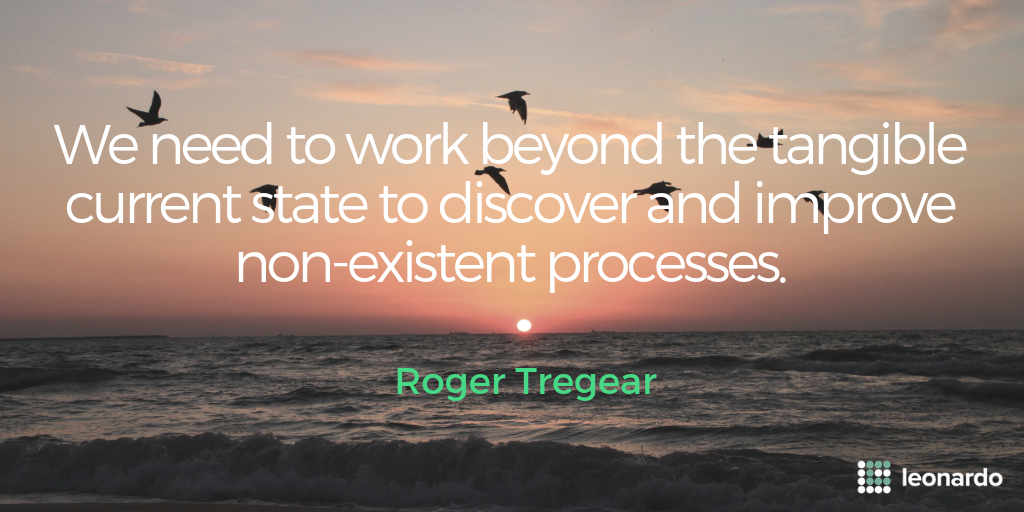 There is often a tension between process improvement and innovation. Improvement is seen to be just fiddling around at the edges, rather than making the massive gains offered by radical transformation. Continuous process improvement is important, and we also need discontinuous innovation. However, process improvement needs a performance boost; as well as counteracting weaknesses and threats, it needs to focus on opportunities and strengths. We need to work beyond the tangible current state to discover and improve non-existent processes.
There is often a tension between process improvement and innovation. Improvement is seen to be just fiddling around at the edges, rather than making the massive gains offered by radical transformation. Continuous process improvement is important, and we also need discontinuous innovation. However, process improvement needs a performance boost; as well as counteracting weaknesses and threats, it needs to focus on opportunities and strengths. We need to work beyond the tangible current state to discover and improve non-existent processes.
Imagine this. Monday morning 9:05, and we are at a government agency starting an in-house five-day training course on process analysis and improvement. My 25 students are all eager to get going, and their CEO is there to kick us off with some well-chosen words of encouragement (I know she had good words, because I wrote them for her). Going completely off script, she starts out by saying, “I’m not interested in improvement—I want innovation!” Interesting way to start a week all about improvement!
I knew what the CEO meant. She’d had too many experiences where process-improvement exercises had delivered lots of recommendations, but very little change. She wanted stuff to happen; she wanted the performance of the organization to be demonstrably and significantly improved. Her targets weren’t aspirational—they were real, practical, and urgent. Just as Edison did not invent the light bulb by improving the candle, she could see that incremental change was unlikely to be enough to meet her objectives. She was understandably concerned that her well-meaning analysts were about to fiddle about at the edges, while ancient, deeply-flawed processes burned up her budget, public goodwill—and, perhaps, her next employment contract.
Our CEO wanted us to be improving processes that didn’t yet exist. That’s a challenge both impossible and necessary. Although it is important to pursue continuous improvement, there is a limit to the benefits to be gained by incremental improvement; from time to time, we need to make a significant leap to a whole new performance level.
There are many ways to categorize innovation: lifecycle, industry, impact, scope, product, process, source, internal vs external, and marketing methods. This discussion focuses on process innovation, which heavily influences all innovation, since my definition of a process includes all the activities required to transform inputs into outputs, and all the elements required for management and execution of the process.
There are two key differences between process improvement and innovation. They are both about change and, inevitably, that is about changing processes. The first difference is a matter of degree: how much change is involved? An innovation will result in a new process that is radically different to the one it replaces. A more modest process improvement leaves us with a process that is recognizably the same, although improved in some way.
The second difference comes from the drivers of the ideas for change. There are two broad categories, with some overlap.
Innovation will generally be idea driven, while process improvement will be performance driven. Process improvement will be based on a problem looking for a solution (e.g. we need to take two weeks out of the supply chain execution time). Innovation will likely come from a solution looking for a problem (e.g. how could we use RFID technology to improve our supply chain?).
We need both: continuous improvement and discontinuous innovation.
Big problems and big opportunities require big change. Opportunities and problems are also changing; largely, but not only, because of digitization, they are morphing into something qualitative and quantitatively different: check-in becomes check-through; a shopping list becomes a shipping list; and a regular check-up changes to continual assessment.
The process of process improvement needs a lot of work. It is too often restricted to resolving operational problems defined by performance data and failure reports. Current and urgent defects must be fixed expeditiously, but that should not limit the scope for improvement.
If the airport check-in counter queues are too long, many things might be analyzed: physical queuing arrangements; the number of check-in staff available, and their level of efficiency; common problems that slow the process; business rules regarding status and upgrades; possible IT changes, etc. Perhaps, though, you could challenge the need for check-in counters, or even the need to check in. What if a simple fingerprint scan was enough to check in? Or, perhaps, the detection of a passenger’s smartphone on arrival at the terminal checks them in automatically. What queue problem?
Process improvement is about SWOT: strengths need to be protected and amplified, weaknesses need to be removed, opportunities needs to be seized, and threats need countermeasures. The problem is we almost always focus on the W, and perhaps the T—the negative perspectives. Innovation happens in the O, and perhaps the S.
In analyzing processes, we need to put much more emphasis on The Big O; this is where innovation happens. Of course, we need to improve the candle, and we also need to invent the incandescent light bulb—and then go on to invent the LED, then the LED smart light, and then… whatever comes next.
Process improvement suffers if we are just working with what we have now, what we can see and touch. To maximize the benefits, we need to also consider what is not there; those future processes that have the potential for radical improvement.
Incremental improvement of the current state is important and, if done properly, delivers significant benefit. Innovation leading to radical improvement comes when we explore non-existent processes.




